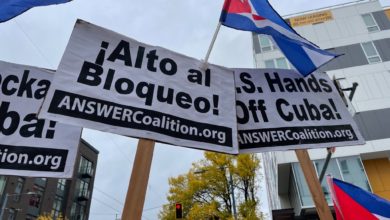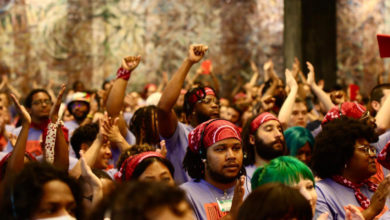
After 45 years of U.S. blockade and aggression, Cuba may be facing its greatest threat yet from U.S. imperialism. The Bush administration is implementing the report of the “Commission for Assistance to a Free Cuba.”
The 480-page report—a sweeping blueprint for a complete takeover of Cuba by the United States government—was unveiled on May 6 by the commission, headed by Secretary of State Colin Powell. It lays out major economic and political measures designed to asphyxiate Cuba’s economy, which are then supposed to help “bring about an expeditious end to the Castro dictatorship.”
The measures outlined in the report began to take effect on June 30, and are widely recognized as a significant escalation in the 45-year-old campaign of aggression by the United States against Cuba.
In Cuba, millions of people responded with mass mobilizations warning the U.S. government not to contemplate military action or other dangerous provocations. Although the Bush government claims it is acting to “free” the Cuban people, its main target and victim is precisely the Cuban people, both the 12 million Cubans on the island and Cuban-Americans living in the United States.
Some of the numerous measures being implemented include severe restrictions on Cuban-Americans’ right to visit family members in Cuba or to send remittances; the funding of $58 million to create and foment subversion inside Cuba; military flights beaming U.S. propaganda over Cuban TV and radio broadcasts; and the strengthening of sanctions against any entity doing business with Cuba.
This stepped up aggression on the part of the Bush administration comes in the aftermath of the invasion of Iraq. No sooner was Iraq bombed and occupied last spring than government spokespeople began to warn Cuba to heed “the example of Iraq.” In October 2003, Bush announced his presidential commission on Cuba.
On May 6, 2004, Roger Noriega, Assistant Secretary for Western Hemisphere Affairs, a rabid anti-Cuba advocate and a member of the commission, gave a press conference to summarize the commission’s report. He said the U.S. would no longer “wait for a free Cuba, we’re working for a free Cuba.”
“It’s unprecedented,” Noriega continued. “For the first time ever, a U.S. administration has articulated a definitive, decisive and integrated strategy that represents a national commitment to help the Cuban people bring an end to the Cuban dictatorship and to be prepared to support a democratic transition in meaningful, specific, explicit ways once that transition is underway.”
The commission’s working group on “Hastening Cuba’s Transition” includes the departments of State, Defense, Homeland Security, Commerce and Treasury, as well as the National Security Council, U.S. Agency for International Development and the Foreign Claims Settlement Commission.
Such a coordinated plan, bringing together so many arms of the imperialist state, must be regarded as constituting a clear and ominous threat.
Yet, 45 years of blockade and aggression, while severely impacting Cuba, has failed to force the Cuban Revolution into submission. The corporate and military rulers of the United States are fully aware that the blockade has not “succeeded.” With all their lies about a Cuban dictatorship repressing the population, they know the revolution enjoys overwhelming support.
Therefore, the most essential part of the commission’s report—to restore capitalism through invasion, occupation and counter-revolution—is deliberately hidden to avoid opposition among the U.S. people who are increasingly questioning the “endless war” in Iraq, Afghanistan and elsewhere.
A constant in U.S. foreign policy

Seeking to overthrow the Cuban revolution is nothing new for the U.S. government. It has been part and parcel of U.S. foreign policy since the Eisenhower administration. In the early months of 1959, Eisenhower, the Pentagon and CIA plotted “Project Cuba,” a deep-cover strategy employing sabotage, assassination, economic blockade and terrorism to bring down the revolution.
Nine other U.S. presidents have fashioned their own version of Project Cuba over the years, but to no avail. While tactics may have varied from one administration to another, the objective remains the same: the destruction of the Cuban Revolution.
All the post-Soviet era U.S. presidents—Bush I, Clinton and Bush II—promised that he would be the first U.S. president to enter a “free Cuba.” They were convinced that Cuba would fall after the Soviet Union’s disappearance. All that was needed, each believed, was another shove by the U.S.
In the 1990s, Cuba faced its most severe test of survival, when 87 percent of Cuba’s traditional trade with the socialist camp abruptly disappeared. The U.S. imperialists, Democrat and Republican alike, drew their knives for what they were sure would be the final kill.
But Cuba’s revolutionary mass organizations and Communist Party, led by President Fidel Castro, made a pledge that the country’s independence and socialist system would be defended to the death if necessary.
Cuba’s “Special Period” vs. U.S. economic blockade
Cuba titled its struggle for survival the “Special Period in Time of Peace.” With a thorough explanation through the nation’s mass media and through discussions at every level of society of the economic situation and the fight at hand, the people were politically prepared to resist.
The economy was reoriented to allow limited capitalist-style measures, while maintaining the socialist foundation and gains of the Revolution. Joint venture investment was encouraged, tourism was developed to ensure a source of hard currency, and self-employment was permitted. Subsidies were greatly reduced or eliminated in unproductive enterprises.
Cuba’s Gross Domestic Product (GDP) dropped 34.5 percent from 1990 to 1993. By comparison, the U.S. GDP fell about 24 percent during the Great Depression of 1929-33, which led to massive social displacement and homelessness. But under Cuba’s socialist system, no schools or healthcare centers were closed, and low prices of rationed food were maintained. No family was evicted from their home.
Washington was not an idle observer of Cuba’s crisis. Two major acts were passed in Congress and signed into law, each tailor-made to cut off Cuba’s links to the world and further raise the level of suffering among the Cuban people.
In October 1992, George Bush Sr. signed the notorious Torricelli Law (the so-called “Cuban Democracy Act”), with the full backing of his main rival in that year’s presidential election, Bill Clinton. The law barred any ship in the world from docking in a U.S. harbor if it contained goods destined for Cuba during its journey. Any country or corporation would be hard-pressed to choose Cuban trade over trade in United States markets. It also banned U.S. subsidiaries in third countries from selling goods to Cuba.
The impact of the Torricelli Law was brutal: Cuba’s purchases of essential food and medicines from U.S. subsidiaries were cut from $900 million to $1.6 million in the first year of the law’s existence.
Instead of collapsing, however, Cuba began a slow but steady recovery through sacrifice, hard work and a series of economic reforms.
In a decade that left underdeveloped countries submerged in debt and politically subordinated, Cuba’s socialist system and planned economy enabled it to marshal its meager resources toward strategic development.
Despite shortages of food that lowered the daily average caloric intake from 2,800 to 1,600 in 1993, there were no food riots, no public ransacking of stores. Available food was equitably rationed to prevent starvation.
Critical to the people’s unity was the profound understanding that no class of capitalist owners was living high while the masses went hungry. The cadre of the Cuban Communist Party led by example in the sacrifices and struggle, and in providing the perspective that what was being undertaken was not “market socialism,” but a necessary concession of introducing market reforms to save the revolution.
Finally, the gains in tourism income and restarting of industries like nickel mining resulted in a 5.4 percent growth in economic production from 1995 to 1996. The recovery has continued since then.
Advancing in the face of aggression
But Cuba’s survival remained anathema to the U.S. rulers, who promote the idea that the prolonged suffering of the people will eventually bring them around to embracing the very system of imperialism that is trying to strangle them.
On the heels of the Torricelli Law came the Helms-Burton Act, sponsored by extreme right-wing members of the Senate and House and signed into law by President Clinton in 1996.
Cynically titled the “Cuban Liberty and Solidarity Act,” the Helms-Burton Act, like the Torricelli law, was designed to hit Cuba’s economy by severely cutting its foreign trade. A major aim of Helms-Burton was to internationalize the sanctions, to force other countries and international companies to halt investment in, and normal trade with, the island nation.
Remarkably, the combination of the collapse of the Soviet Union, U.S. blockade and extremely punitive U.S. legislation has failed to bring down the Cuban revolution.
Cuba’s economic and social indicies in the present period are proving the superiority of revolutionary socialism: the unemployment that Cuba experienced in the 1990s from the economic shock has been reduced to 2.3%, and the infant mortality rate rivals that of industrial countries, with 6.0 deaths per 1,000 live births. Cuba’s internationalism remains exemplary, with the Caribbean island dispatching 20,000 medical doctors to 64 countries in need of healthcare.
But rather than deter the U.S. rulers, this reality has spurred them on an even more aggressive course, including the possibility of military action.
The most ominous proposal of the “Commission for Assistance to a Free Cuba” is Chapter I, Part VIII, entitled “Undermine the Regime’s Succession Strategy.” This section openly discusses plans to stage a counterrevolutionary intervention and to block succession in Cuba following the retirement or death of President Fidel Castro.
The Cuban people have responded to the latest threats with defiance at every level—from mass demonstrations to President Castro’s open letter to Bush to outright military preparations. This heroic defiance demands the support and solidarity from all progressive, antiwar and socialist people in the U.S. and around the world.
More than 1.2 million Cubans rally in Havana on May 14, 2004 to protest the new measures imposed by the Bush administration.
Photo: Jorgelus Gonzalez
Despite the blockade, Cuba enjoys a literacy rate over 98%.
Photo: Bill Hackwell





